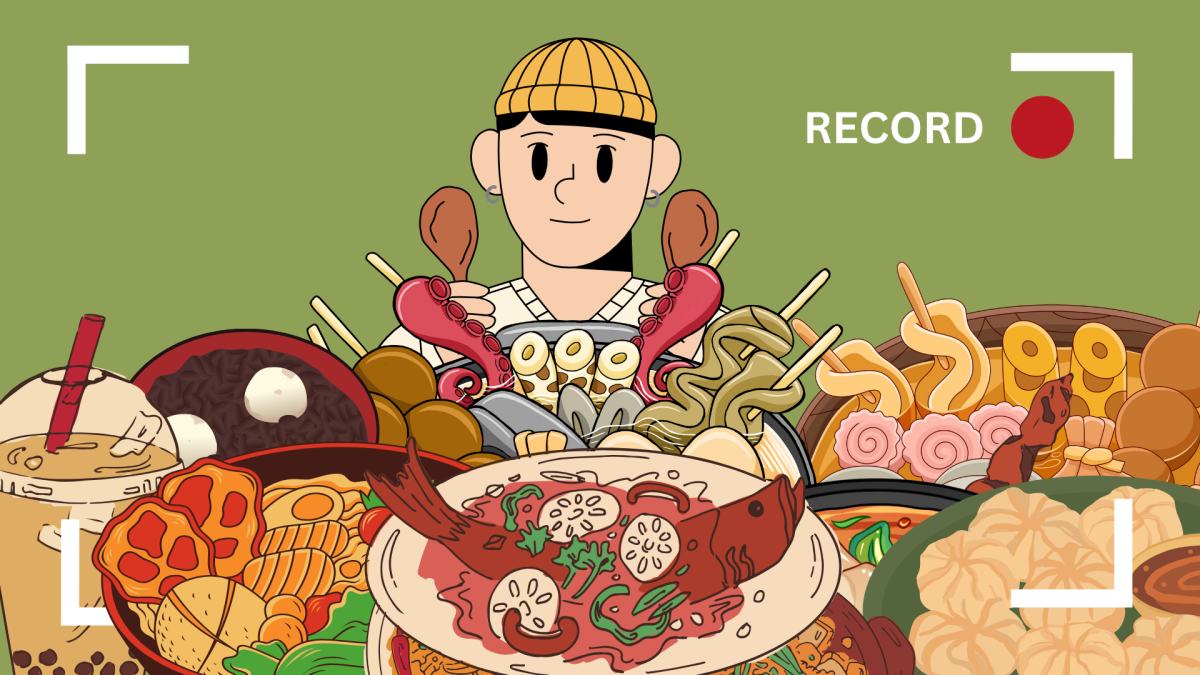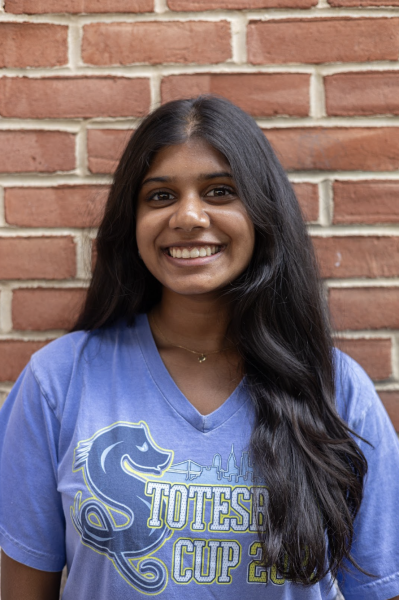A table overflows with mountains of greasy fast food, towering stacks of sugary desserts and bowls of dyed noodles. A microphone amplifies every crunch and smack as the content creator consumes each bite of food. This spectacle is not just for display; it’s part of a growing phenomenon known as a mukbang.
Originating in South Korea around 2010, a mukbang — derived from the Korean words for “eating” and “broadcast” — has shifted from a communal dining experience into a global trend that can glorify extreme eating.
Mukbangs began as a solution for loneliness in South Korea, where the country’s culture involves eating with others. Individuals would seek companionship through a virtual “meal buddy,” offering a way to combat isolation by simulating sharing a meal with others through a live social media feed. With the trend’s rapid global spread, particularly on platforms like YouTube and TikTok, mukbangs have evolved as influencers tap into viewers’ appetite for visually stimulating content. Some internet users believe this has created an industry of content creators pushing their bodies’ limits to capture viewer attention.
Registered dietician Lauryn Bernstein considers the emerging dark side of mukbang videos.
“These videos glamorize overeating and encourage people to ignore their underlying hunger and fullness cues and instead eat to excess,” Bernstein said. “Mukbang videos also encourage viewers to test out extreme eating behaviors on their own, potentially contributing to unhealthy eating patterns and other distorted views around food.”
One prominent figure in the industry is Nicolas Perry, known online as Nikocado Avocado. While he started his influencer career as a vegan blogger, Perry transitioned to the mukbang scene in 2016, and his videos skyrocketed in popularity. However, as he shifted to eating large amounts of unhealthy, processed food, his mental and physical health declined. Videos showed Perry breaking down as he shoved food into his mouth, racking up millions of views.
Viewers like junior Ethan Stearns are drawn to Perry’s videos because they find his behavior appalling,
“I definitely felt uncomfortable and disgusted while watching those videos,” Stearns said. “He was a pretty healthy guy at one point, and then he binged a lot of food really quickly, and that kind of sent him off the deep end.”
His videos have contributed to a trend of creators exploiting algorithms that push extreme content, encouraging addictive behavior. A content analysis study of mukbang YouTube videos found that 84% featured overeating, particularly junk food with low nutritional value. Trends like the 10,000-calorie challenge emerged, requiring people to eat 10,000 calories of food in 24 hours, with some content creators increasing the goal to 30,000 calories.
True Food Kitchen worker and Whitman junior Sophia McCormick said these challenges perpetuate an unhealthy image.
“That type of content normalizes unhealthy eating behaviors, and many videos are edited to make it more appealing and achievable for regular viewers,” McCormick said.
Bernstein says these eating behaviors can be misleading because they aren’t always transparent.
“Additionally, these videos only highlight a small portion of the content creator’s life, offering no context beyond what’s shown on camera,” said Berstein. “This can lead to unrealistic comparisons and expectations for viewers.”
In one of Perry’s more recent videos, released Sept. 6, 2024, he revealed that he hid his 250-pound weight loss from the internet for over two years to prove a point,
“While everybody pointed and laughed at me for over-consuming food, I was in total control the entire time,” Perry told NBC News. “In reality, people are completely absorbed in internet personalities and obsessively watch their content. That is where a deeper level of over-consumption lies — and it’s the parallel I wanted to make.”
Other content creators have fallen into a similar pattern of content. A TikTok creator by the username “Jellybean.sweets” racked up over 5.8 million views after posting a clip of her trying chicken after being a pescatarian for five years. After her burst of fame, she shifted from dancing videos to solely posting content of her eating copious amounts of fast food. Stearns said this shift in content strategy reflects a harmful trend of seeking clicks through extreme eye-catching behavior.
“They realize that they can make money off of it,” Stearns said. “They get attention from doing it.”
The short-term validation of chasing views, artificial affection and the dopamine hit of a binge fest can lead to mental and physical health complications and a disordered eating cycle.
Pan Xiaoting, a Chinese streamer, died at the age of 24 on July 14th, 2024, during a livestream mukbang session. Before her death, Xiaoting was taking on extreme challenges, eating for more than ten hours at a time. Her autopsy showed deformity and undigested food in her stomach. This wasn’t the first time her habits negatively impacted her health; Xiaoting had previously been admitted to the hospital due to gastrointestinal bleeding, yet she resumed binge eating for her broadcast the day after she was discharged.
As mukbang continues to captivate audiences worldwide, it has also attracted a particular subculture: feeder fetishism. In this sexual kink, individuals derive pleasure from encouraging weight gain through the consumption of food. Critics recognize the discourse around the fetish because of its potential to harm.
“It’s a controversial fetish because it can be detrimental to the feedee’s health,” said Sex and Culture Critic Magdalene J. Taylor.
Thousands of men pay for customized feeding content on platforms like OnlyFans, incentivizing creators to prioritize extreme consumption over health. With over 30,000 feeding-related accounts on such platforms, this fetish has reached mukbangers’ audiences. Some find it to be disturbing, especially because it can be harmful.
“It makes the internet scarier because mukbangs are such a normalized form of content, but much of it attracts an audience motivated by creepy fetishes,” McCormick said.
Research indicates that viewers turn to mukbangs for various reasons beyond mere entertainment. Some watch for social connection, others for sexual gratification, and some use it as a form of vicarious eating while on diets. Studies have also shown that excessive mukbang viewing correlates with unhealthy eating habits and distorted perceptions of portion sizes among audiences, and the glorification of binge eating can lead to serious health complications.
“Health risks that could be associated with extreme eating include increased risk for developing chronic disease including heart disease and diabetes, as well as increased risk for developing disordered eating patterns and eating disorders,” Bernstein said.
Additionally, as content creators chase the algorithm with shock factor thumbnails, the controversial consumption of live animals, especially seafood, has risen in the mukbang community. Influencers like the host of “Ssoyoung,” a Korean YouTube channel, have faced significant backlash for videos featuring the consumption of live octopus, squid and other marine creatures. One of the most popular videos, garnering over 24 million views, shows Ahn So-young, the host, cutting off squid heads and pouring soy sauce on them while they flail. This content has sparked debates about animal cruelty and the lengths people will go to attract views.
While mukbang was initially rooted in cultural practices aimed at alleviating loneliness, its evolution raises serious concerns about health and well-being. As the trend continues to captivate global audiences, the exploitation of creators’ bodies, the normalization of disordered eating habits and the emergence of disturbing subcultures have led to debate about regulation in the digital content sphere.
“It’s so hard to regulate on the internet these days. Regulation is necessary, but mukbangs are overlooked in that sense,” McCormick said. “We need to represent a healthier relationship with food on the internet.”












